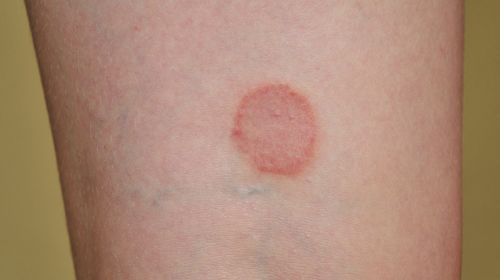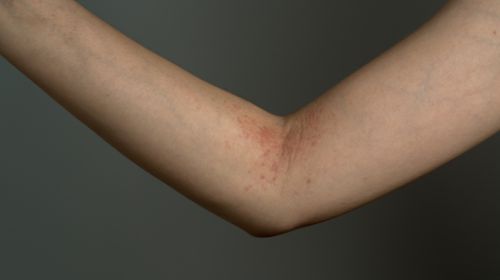Intertrigo (skin wolf) is a common diagnosis. Nevertheless, many people do not know what it means. Find out here what exactly intertrigo is, what treatment helps and how the skin disease can be prevented.
- © Getty Images/Albina Gavrilovic
Quick overview: Frequently asked questions and answers
What is intertrigo? Intertrigo is an inflammatory skin disease that occurs primarily in skin folds caused by friction, moisture and heat. It often occurs in the groin area, the armpits, in the diaper area in babies and under the breasts in women.
How do you treat intertrigo? Affected areas of skin should be kept dry, for example with wound compresses. Anti-inflammatory ointments or pastes containing zinc provide relief. If symptoms do not improve after a week, medical advice should be sought.
What are the symptoms of intertrigo? Redness, burning, itching and oozing are typical. If the affected area is infected, pain, pustules, crusting and sometimes bleeding also occur.
At a glance:
What is intertrigo?
An intertrigo (colloquially known as skin wolf) is by definition a superficial eczema that occurs primarily in body folds (intertrigines).
It is a form of contact dermatitis: friction, moisture and heat combine to damage the surface of the skin (maceration), which can become a good breeding ground for bacteria and/or yeast.
Frequently affected skin areas
Intertrigo often appears
- below the chest and buttocks,
- in the genital area,
- in the groin region,
- in the diaper area,
- on the inner thigh,
- in buttock crease,
- in abdominal folds,
- in armpits or
- in the spaces between fingers and toes.
It is not possible to reliably determine how widespread the skin disease is in the general population. Women are affected more often than men. Because being bedridden is a risk factor, it is estimated that around 20 percent of all people over 80 suffer from the skin disease.
How does intertrigo develop?
The disease always begins with a simple skin irritation. It can have various causes, often occurring in combination, for example:
- Skin-to-skin friction
- abrasive clothing or diapers
- Moisture and/or heat build-up
- altered pH value of the skin
Special risk factors include:
-
poor personal hygiene
-
excessive personal hygiene/care
-
Care products that unbalance the pH value of the skin
-
humid-hot climate
-
heavy sweating
-
Overweight/obesity (promotes the formation of skin folds)
-
Endurance sports such as jogging or cycling: especially when skin rubs against each other. Colloquially, this is also referred to as “running like a wolf”
-
poorly cut clothing that rubs against the skin
-
Clothing made of materials that do not wick away moisture (e.g. certain synthetic fibers)
-
poorly ventilated shoes
-
Wearing diapers
-
Wearing prostheses
-
Incontinence (can lead to accumulation of urine or stool in the genital or anal area)
-
weakened immune system
-
Diseases that weaken the skin barrier and delay wound healing (e.g. diabetes mellitus)
-
limited mobility or bed rest (because certain areas of skin are exposed to one-sided pressure).
In summer, increased sweating and wearing shorts or skirts also quickly lead to skin irritation between the legs.
A persistent build-up of moisture on irritated skin areas, such as in abdominal folds, often leads to the upper layer of skin (epidermis) swelling. The affected area of skin provides an ideal breeding ground for bacteria (e.g. staphylococci) and fungi (the yeast Candida albicans is common).
Symptoms: How can intertrigo be recognized?
The following symptoms are typical:
- Redness
- overheat
- itch
- Burn
- Wet
The transitions between intertriginous eczema and other inflammatory skin diseases (dermatitis) are fluid. The location of the affected skin area (body folds or other intertriginous areas) is usually used to differentiate between them.
Infection associated with further complaints
If the damaged skin area becomes infected with fungi and/or bacteria, this can cause further symptoms and abnormalities, such as:
- Pains
- Increased itching/burning
- Pustules and papules/nodules (especially in the peripheral area of the inflammation)
- (weeping) blisters
- whitish deposits
- reddened, open, sometimes bleeding areas
- Hornification/thickening
- Crust formation
- sweet-rotten or otherwise unpleasant smells
How is intertrigo diagnosed?
The right place to go is a dermatological practice.
The relevant areas of skin are first examined (visual diagnosis). If necessary, a small skin sample is taken to examine it under a microscope and/or to detect fungal infections or bacteria using a cell culture.
If the appearance and location of the dermatitis are characteristic, the suspicion of intertriginous eczema is confirmed.
Intertrigo: This is what the treatment looks like
The treatment depends on the severity of the skin disease. If the intertrigo is still in the early stages, there is a chance that the irritation will go away on its own once the cause has been eliminated (for example, by changing clothes).
Otherwise, there are the following recommendations and treatment measures:
-
keep affected area dry: Larger, inflamed intertriginous skin areas should be kept as dry as possible, for example by using sterile wound compresses. Careful, regular blow-drying, preferably with cold air, can also speed up healing.
-
prefer breathable fabrics: If the affected part of the body is covered by clothing, the material should be breathable and washable at at least 60 degrees.
-
Apply ointments: Wound healing powders with zinc oxide absorb sweat/moisture and have an anti-inflammatory effect. Zinc creams and ointments also dry out the skin slightly and relieve itching.
-
good hygiene: To reduce the risk of infection with bacteria and/or fungi, frequent changing of compresses and clothing is important
If the affected area of skin itches or burns, pustules, papules or blisters become visible or unpleasant odors are detected, it is important to visit a dermatologist’s practice promptly.
When to see a doctor?
If symptoms do not improve or if they worsen, medical advice should be sought within seven days at the latest.
Disinfectant (antiseptic) ointments and lotions are often prescribed for treatment. If a yeast infection is detected, antimycotic (antifungal) drugs are used.
In more severe cases, cortisone creams or cortisone ointments can inhibit the inflammation. In order to prevent the formation of resistant bacteria, the use of antibacterial (antibiotic) agents is generally avoided today.
It is important to apply the prescribed creams, ointments or lotions exactly as instructed (thinly): A thick layer of cream keeps the inflamed skin areas moist, which can prevent healing.
If several inflamed areas of skin show a fungal infection at the same time, depending on the severity, additional oral intake of an antimycotic may be necessary.
Intertrigo: prognosis and course
At the beginning, the disease is usually limited to a small, sharply defined reddening of the skin. As the disease progresses, the affected skin area often becomes inflamed and expands. Fungal and/or bacterial infections are common.
In severe cases, the surface of the skin (epidermis) sometimes peels off, creating a large, open wound. To prevent the symptoms from worsening and/or becoming chronic, larger skin eczema should always be treated professionally.
Since open wounds are a gateway for germs, chronic intertrigo can be particularly dangerous for older, immunocompromised or chronically ill people.
How long does the healing take?
In general, intertrigo is easy to treat. However, the healing time depends on the degree of inflammation, the size of the affected skin area and the general condition of the patient.
In the case of intertrigo without infection, it takes about one to two weeks for the skin to recover with appropriate medication. If there is a fungal or bacterial infection, treatment may be necessary for up to four weeks.
Prevention: How can intertrigo be prevented?
In principle, incipient skin irritations should be treated consistently and, if symptoms persist, medical attention should be sought promptly.
Various measures can contribute to intertrigo prophylaxis, i.e. the prevention of intertriginous eczema:
-
right clothing: Wear comfortable and breathable underwear and clothing that does not rub against the skin and is made of natural fibers (e.g. linen or cotton). When doing sports, you should use special, moisture-wicking functional underwear/bras and clothing.
-
good skin care: Use skin-friendly creams or lotions containing panthenol or urea. The products should be applied evenly and thinly to vulnerable areas of the skin to prevent the formation of a film that could lead to moisture build-up.
-
dry properlyAfter bathing, swimming or showering, always dry your entire body thoroughly, including every fold of skin and every space between your toes; if necessary, use a hairdryer as well.
-
Maintain normal weight: Avoid being overweight or, if necessary, reduce your body weight to prevent skin wrinkles.
-
Protect irritable skin areas: Protect vulnerable areas of the body with cotton compresses or gauze pads and keep them dry.
-
Avoid bedsores: If you are bedridden, change your position frequently to avoid bedsores.
-
Consider underlying diseases: In case of chronic diseases such as diabetes mellitus, pay attention to proper care and go for regular foot care.
Source: www.lifeline.de




